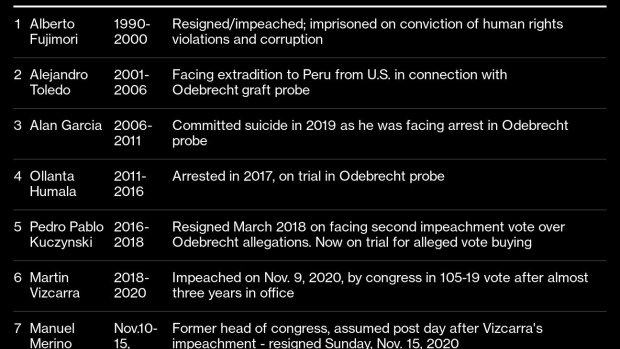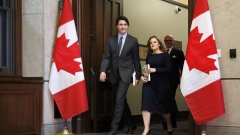Mar 28, 2022
Castillo Risks Being Toppled by Impeachment Vote: Peru Timeline
, Bloomberg News

(Bloomberg) -- Pedro Castillo went from being a virtually unknown former school teacher to president of Peru last year, in one of the quickest ascents in political history. He now risks a similarly swift exit from office.
On Monday, Castillo faces the second attempt by opposition lawmakers to oust him for “permanent moral incapacity,” after just eight months in power. At least 87 of the 130 lawmakers would need to vote to eject him from the presidency, in which case Vice President Dina Boluarte would take over as head of state. The fact that the process was supported by 76 votes suggests the final vote will be a close call.
Peru’s constitution makes it easier to oust a head of state than it is almost anywhere else. Another president, Martin Vizcarra, was impeached less than two years ago.
Here are some highlights from Castillo’s rocky presidency:
April 2021: Assets Plunge
Peru’s bonds, stocks, and currency plunged when Castillo, a teacher from a remote rural district, defied polls to unexpectedly win the first round of Peru’s presidential election. In July, he was finally declared the winner of the runoff vote, beating Keiko Fujimori by 50.1% to 49.9% after six weeks of revisions and allegations of fraud. He took office on July 28 and further spooked investors by naming Guido Bellido as prime minister. Bellido, a member of Castillo’s socialist Peru Libre party, had never held public office and described Cuba’s communist regime as a democracy.
Read More: Havana-Trained Marxist Pushes Peru’s New President to the Left
August 2021: First Minister Quits
Just three weeks after the inauguration, Foreign Minister Hector Bejar resigned, denounced for spreading conspiracy theories blaming Peru’s navy for terrorist atrocities. The frequent loss of ministers to various scandals over the next few months created a near-permanent sense of crisis around the Castillo administration. At the start of September, the nation’s credit rating was downgraded a notch to Baa1 by Moody’s Investors Service.
October 2021: Supporters Slam New Cabinet
Castillo appointed a new cabinet to try to improve relations with congress. The move was popular with investors, especially since it meant the departure of Prime Minister Bellido, but the changes angered Castillo’s left-wing base. Another political crisis came to the boil as Castillo’s own party, Peru Libre, dropped its support for the government over the new cabinet. Shortly after, Peru’s credit rating was cut a notch, to BBB, by Fitch Ratings.
December 2021: First Impeachment Vote
The nation had narrowly avoided a constitutional crisis in November when the cabinet won a vote of confidence in congress. Also that month, anti-corruption investigators searched the presidential palace as part of a probe into influence-peddling by a Castillo aide.
In December, congress rejected an attempt by opposition lawmakers to impeach Castillo, by 76 votes to 46 with four abstentions. The president had secured last-minute pledges of support from key groups in congress.
February 2022: Fourth Prime Minister Named
Castillo named Hector Valer as his new prime minister, a day after his second premier, Mirtha Vasquez, quit. Valer resigned after four days following accusations of domestic abuse. Castillo then named Anibal Torres as his fourth prime minister since July.
Castillo denied allegations made by a businesswoman, Karelim Lopez, under investigation for money laundering, that he was involved in irregularities over the bidding process for a bridge contract.
Read More: Peru’s President Names His Fourth Prime Minister Since July
March 2022: Second Impeachment Vote
Congress opened a second impeachment process against Castillo, again for “permanent moral incapacity,” citing Lopez’s allegations. The president will defend himself before the unicameral congress on Monday, or send his lawyer to do so.
Read More: Peru Congress Opens Impeachment Proceedings Against Castillo
©2022 Bloomberg L.P.








